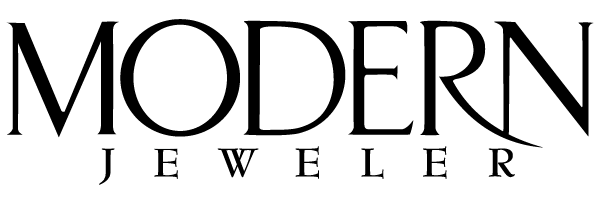At its breathtaking best, tanzanite looks the spitting image of Kashmir sapphire—exhibiting the rich, royal velvety blue those stones are prized for. But costing a fraction of the price. Then the merest hint of violet creeps in and tips off experts that the stone is something else.
That “something else” is a blue zoisite, rechristened tanzanite by Tiffany in 1969 to honor its one source, Tanzania, and considered by many the pride of that gem-rich East African country. “It’s so good to know there is a stone that is still actively mined that gives you the Kashmir-blue color which is the ultimate for blue in gemstones,” says famed cutter Reggie Miller, Reginald C. Miller Inc., New York.
But the fact that some tanzanites resemble Kashmir sapphires doesn’t fully explain the red-hot demand for 1- to 6-carat sizes in all shades of this presently plentiful zoisite. Indeed, the stone seems well on its way to becoming a jewelry store staple.
Obviously, price has a lot to do with tanzanite’s success. Fine stones in 2- to 3-carat sizes shouldn’t cost jewelers more than $400 per carat, probably closer to $300 per carat. And no one quoted us prices above $800 per carat for comparable fine 4- to 6-carat stones. Indeed, many superb stones are available in these sizes for between $400 and $600 per carat.
Undoubtedly, however, the best bargains around in tanzanite today can be found in currently unpopular sizes above 10 carats. Large stones that once commanded up to $1,800 per carat in 1980 now rarely fetch above $900 per carat. These prices reflect tanzanite’s status change from collector to consumer stone. For years, collectors were the primary buyers of tanzanite. Since they bought stones as showpieces, they concentrated on very large sizes. But ever since investment gems crashed in 1981, collectors have been absent from the market, leaving retailers to take up the slack.
Not a Sapphire Substitute
As retailers and jewelry manufacturers became the primary users of tanzanite, size preferences dropped decidedly below 10 carats into the 1- to 6-carat range. At the same time, the gem has begun to be appreciated for more on its own terms and far less as a sapphire substitute.
This isn’t to say that the old connoisseur color ideal for this gem, a Kashmir blue, was abandoned. But there is greater adoration for tanzanites that don’t ape fine sapphire, a factor slowly freeing the gem from its second-class status as a sapphire substitute. As Los Angeles gem importer Bobby Flusser, Overland Gems Inc., puts it, “There is a need for a violet-blue stone in between, say, sapphire and amethyst that tanzanite fills.” On those grounds, Flusser continues, “we feel that violetish tanzanites are as beautiful and deserve as much praise as the Kashmir-blue ones.”
Veteran tanzanite importers and cutters still object to aesthetic parity between Kashmir-blue and violetish-blue stones. One of them, Miller, insists that judging tanzanite according to a sapphire-color standard does not make the stone a sapphire stand-in. “Who said tanzanite is a sapphire substitute?” he asks. “After all, it’s priced for a color that few modern sapphires possess.”
In any case, there is a radical split in taste between major marketers of tanzanite. Some middle-of-the-roaders like author and dealer Joel Arem, Turmal Intl. Inc., Atlanta, Ga., say the division boils down to a matter of economics. “It is going too far to say that Kashmir-blue and strong violetish-blue tanzanites are equals. The Kashmir color is finer,” he explains. “But more violetish stones are attractive and need no apologies. The important, the economics of cutting will always dictate a preponderance of these stones.”
Weight Versus Beauty
Arem is right. Strong violetish blue will always dominate market supply. Although Miller readily concedes this, he adds that it’s not nature’s fault. This is why he is upset by a lot of the tanzanite he sees. The truth is there could be far more Kashmir-blue tanzanites. Often, it’s simply a matter of cutting the rough a certain way.
Tanzanite is a trichroic stone. This means that it gives off different colors when viewed from different directions, or axes. In tanzanite, one axis is blue, another violetish and the last reddish brown or bronze. When shown tanzanite rough, cutters like Miller look for strong trichroism, plus, of course, intense colors, as desirable signs. After cutting, the stone is heated to induce a permanent color change—usually from a brownish to bluish color. For reasons Miller isn’t sure of, the stones with the strongest reddish brown—without before heating bake to the deepest blue. In any case, in them heating, tanzanite would be unmarketable.
But cooking the ultimate blue out of a stone is finally up to the cutter. And here’s where economics enter the picture. Ordinarily, the best blue comes from cutting along the blue axis. But cutting along the blue axis usually means sacrificing the most rough. In order to get more yield, most cutters cut along other axes. This often produces steel blue or strongly violetish stones which can’t be re-cut afterward produce a bluer color.
Cutters can’t have second thoughts with tanzanite. So a stone’s color is basically irrevocable. Compromising can even affect stones with Kashmir-blue colors because stones are unable to hold their color in a wide variety of lighting conditions. That’s why cutters like Miller make viewing deep blues in incandescent lighting mandatory before offering on them. Should the stone turn violet, the offering price is much lower.
Nevertheless, a growing number of cutters resent residual snobbery against the strongly violetish stones that result when they cut for weight, especially now that such stones are more acceptable. As they see it, by cutting for weight, they keep down the final cost of tanzanite to jewelers and consumers.
Maybe so, say purists like Miller, but for a little more money consumers could have stones possessing a blue color that is among the most cherished gem hues in the world. “The Kashmir-blue color is an ideal that can more readily be realized with tanzanite today than sapphire,” Miller says. “It’s a shame to see so many stones deprived of the chance to embody that ideal.”
Stones that embody the Kashmir ideal have been known to fool jewelers—sometimes with dire consequences. Jewelry bench men with no gemological training who have mistaken tanzanite for sapphire have frequently destroyed stones. The reason: Tanzanite, a soft and more fragile gem than sapphire, cracks, even shatters, when exposed to extreme temperatures or sudden temperature changes.
Please note: this profile was originally published in 1988 in Modern Jeweler’s ‘Gem Profiles: The First 60’, written by David Federman with photographs by Tino Hammid.
The 11.51-carat tanzanite shown in the header image is courtesy of David Humphrey of Geo Design, Pacific Palisades, Calif.






